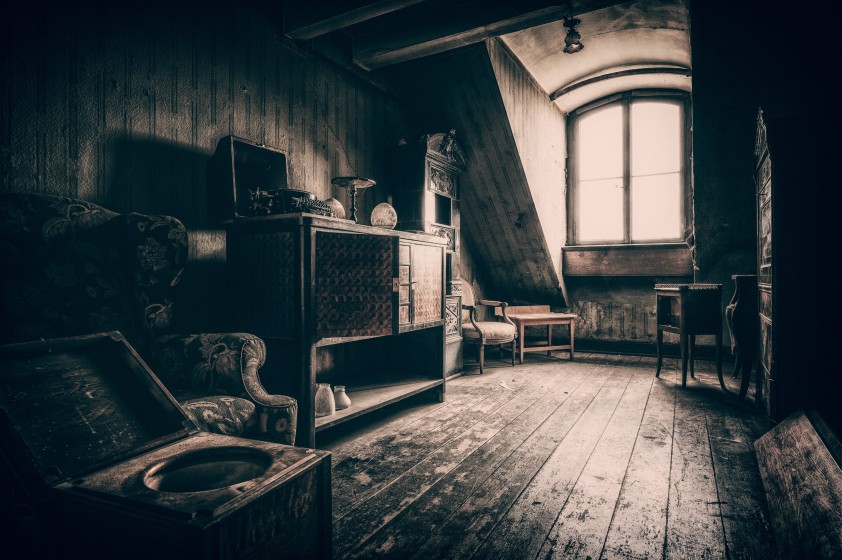
The Furnished Room by O. Henry is a gripping tale about a young man, his relentless search for his beloved and the cruel end that Fate has reserved for him. Dealing with the themes of suffering, isolation, greed, apathy and suicide, The Furnished Room with its combination of mystery, paranormal elements and O. Henry’s signature twist ending makes for a terrific read.
Set in the lower West Side, New York, this grim tale showcases the dark side of the city and the sense of isolation that pervades seemingly crowded areas. It also explores the pain and sufferings of lost love through the obsession and desperation of the protagonist. A young man who is frantically searching for the girl he loves tries to commit suicide upon failing to find her – ironically, in the very room his girlfriend had killed herself just a week ago. First published serially in1904, “The Furnished Room” was later on included in his 1906 collection ‘The Four Million’.
The Furnished Room | Summary
The story opens with a detailed description of the neighborhood which forms its setting– the lower West Side. It is described as being home to a vast number of homeless people, who constantly travel from one dwelling to another, carrying all their worldly possessions with them. These people have no permanent address to call their own and this transience is reflected in their hearts and minds. Just like its occupants, the area carries around it an air of restlessness and unpredictability. The narrator reckons that this district, being home to a vast multitude of dwellers, holds within its houses thousands of stories- some that are dull, and some that might send chills down one’s spine.
One such tale is that of a young man, who after having spent almost the entire day roving among the red- bricked houses, finally finds a place to rest as the darkness of the evening sets in. It is the twelfth house he’s visited that day. Upon ringing the doorbell, he is greeted by a greedy-looking housekeeper seeking to acquire as many lodgers as possible. Upon inquiring about the availability of a room, the housekeeper offers to show him a room on the third floor which has been lying vacant for almost a week.
The young man agrees and follows her to the said room, moving through the dingy, dilapidated stairways. The house appears to be quite old and broken down, almost in the stage of falling into pieces, with its worn-out carpet covered with moss and eerie-looking walls. As they reach the room, the housekeeper informs her guest that the room in the theatrical district rarely remains vacant and has been occupied by many elegant theatre personalities who pay the entire rent in advance. She tells him about the famous people that were her lodgers, in an attempt to entice him into renting the same.
Being tired and weary, the man agrees to engage the room, paying in advance for the entire week and takes possession immediately. As the housekeeper is leaving, she is stopped by him. He asks her whether she knows the whereabouts of a young girl named Miss Eloise Vashner. He describes her as being fair, medium-heighted girl with reddish, gold hair and a dark mole near her left eyebrow. She’s engaged in singing on the stage. However, the housekeeper claims to have no remembrance of encountering anyone matching the description. It is revealed that the young man had been tirelessly searching for this girl, who was his beloved, since the past five months, but is still not able to track her down.
Thus dejected and dispirited, he lies down to rest upon a chair, lost in his resignation. The room, appearing to comfort him with pseudo-hospitality at the beginning, gradually begins telling him about its previous tenants, speaking to him through the various aspects of its furnishing. A multicolored rug lies on the otherwise dirty matting. The wallpapered walls are decorated with generic pictures that travelers find in most of the lodgings. Many items of personal use lie around, probably forgotten by those who’ve vacated the room.
As the current resident of the room surveys his surroundings, he begins to discover things about the previous tenants from the traces they’ve left behind in the room. It seems that the occupants had unleashed all their frustrations on the room. Almost all the furniture bore traces of abuse, some being chipped, and others distorted. Even the floor and mantel have sustained the injuries as the people, for whom the room was their home, albeit a temporary one, wrecked it in their agony.
As the young man muses upon these findings, sounds and scents from the other parts of the house drift towards him. Suddenly, he catches a strong, sweet odor of mignonette, the one that Eloise, his beloved, used to wear. He is absolutely sure that it’s her scent and that she has been in the room before. He feels that she’s somewhere near him as her signature scent envelopes him. He begins looking for other signs of her stay in that room. However, his attempts at locating the source of the scent yields no result.
Thus frustrated, the man seeks help of the housekeeper in the hope that she might lead him to the whereabouts of Eloise. He asks the housekeeper the details of the person who occupied the room before him. However, over the entire year, there had been no visitor that held any resemblance to her. Thanking her, he returns to the room, with his hopes dampened and his spirit disheartened. Losing all hope, he tears the sheets into strips, using them to fill the gaps in the door and the windows in order to block the passage of air. Thus confining himself, he turns on the gaslight, puts out the flame, and lies on the bed, attempting to suffocate himself to death.
Meanwhile, the housekeeper is catching up with her friend over a beer later that evening. She informs the latter about finally being able to rent out the third-floor. When her friend asks her whether she had informed the new guest about what had happened in that room, she reveals her that she hasn’t. She remarks that rooms are meant to be furnished for rent. They are the only means of earning for people like her and letting out the news that someone had committed suicide in the same room will hampered her business. It is then revealed that the girl who had killed herself with gas in that room, exactly matched the one whom the young man had been looking for all this time – she was a fair girl with a dark mole near her left eyebrow.
The Furnished Room | Analysis
Part mystery, part social commentary and part ghost story, The Furnished Room is a tale of love, loss, desperation, greed, suicide and the effect of the city life on an individual’s psyche. The transient and transactional nature of the lifestyle embraced by the city dwelling folks as well as the transient nature of life itself is captured by this story. The futility of one’s efforts in an increasingly hostile world is also touched upon, as can be seen in the relentless search by the man for his beloved which finally results in his death.
This short story, full of ironical instances of which the greatest one is revealed at the very end, is a commentary on the materialism prevailing among the urban population. It shows how when it comes to making profits, modern society disregards all emotions and feelings. With his poignant description of the young man’s quest for his lost love, O’ Henry very beautifully shows how despair can eat up a man’s heart. The imagery used is quite detailed and the woeful tone adds to the tragic revelation at the end. Overall, the story makes for an interesting read.
The Furnished Room | Title of the Story
The Furnished Room is truly an apt title for the story as the room is the centrepiece around which the story revolves. The end of the man’s search, the climax, the revelation towards the end and indeed the very plotline hinges on the room. Its effect can be seen in both on the man’s psyche as well as on the storyline.
While O. Henry is a masterful writer in creating deft character sketches, in this particular story, it is the setting that plays a crucial in shaping the entire story. One may go so far as to say that the room itself is the main character of the story.
Also notice the artificial “furnished” nature of the room, which with its deceiving appearance lures people in, only to disappoint them and lead them towards destruction.
The Furnished Room | Setting
The Furnished Room is an example of a masterful use of the setting to develop the story. This is achieved in two levels – the setting of the city and the setting room itself.
THE CITY – The city-setting is presented as a place of restless movement, where transient humans with no permanent homes flit from one room to another. This rootless nature of people that the city cultivates is brought out by the use of plant imagery in the very first paragraph of the story where the man-made red-bricked district’s artificiality is contrasted with the lack of all that is natural and wholesome:
“ their vine is entwined about a picture hat; a rubber plant is their fig tree.”
We see an even more scathing commentary on the nature of the city-setting when the narrator remarks thus:
But it ( the city) was like a monstrous quicksand, shifting its particles constantly, with no foundation, its upper granules of to-day buried tomorrow in ooze and slime.
THE ROOM – The Furnished Room is an example of how a masterful sketch of the setting can impact the nature of the story. In this regard, the room that the man rents is laden with sociological and psychological significance. On an individual level, the dark, inner room represents the repressed part one’s psyche that the supposedly civilized city-norms bind within an individual. The room is an arena where this repression finds its release. It is, as it were, a region where the Jungian Shadow Side of one’s personality finds its expression. This is reflected in the imagery of violence, brutality and lust that is used to describe the room.
The violence and frustration vented out in the room is seen in the way its furnishings have been abused by the lodgers, an example of which may be seen in the lines below:
A splattered stain, raying like the shadow of a bursting bomb, was witnessed where a hurled glass or bottle had splintered with its contents against the wall.
The room is thus a setting of psychological release not only in terms of an individual, but also in terms of meaningful, intimate relationships that one forges with others and that makes a house a home:
It seemed incredible that all this malice and injury had been wrought upon the room by those who had called it for a time their home
The setting of the room is also symbolic of isolation and loneliness that the city life brings along with it, where, without meaningful relationships to sustain oneself, one feels stranded and lost. This is reflected in the imagery of a shipwreck that O. Henry uses to describe the contents of room left by its earlier occupants:
Upon it was some desolate flotsam cast aside by the room’s marooned when a lucky sail had borne them to a fresh port—a trifling vase or two, pictures of actresses, a medicine bottle, some stray cards out of a deck.
The deceptive artificiality of the “furnished room” is laid bare where O. Henry compares its welcoming nature to the wiles of a woman of questionable repute:
The furnished room received its latest guest with a first glow of pseudo-hospitality, a hectic, haggard, perfunctory welcome like the specious smile of a demirep
Finally, the room also represents the dark underbelly of the city, as seen by the deployment of reeking, decaying imagery used to represent the room both literally and figuratively :
And he breathed the breath of the house—a dank savour rather than a smell—a cold, musty effluvium as from underground vaults mingled with the reeking exhalations of linoleum and mildewed and rotten woodwork.
Thus, the sketch of the setting is masterfully executed by O. Henry to touch upon both the collective and the individual lives of the city dwellers. In this regard, the room may be viewed as the microcosm of modern society itself.
The Furnished Room | Literary Devices
FORESHADOWING – The Furnished Room makes ample use of foreshadowing. However, given O. Henry’s skill in weaving it into the immediate context, it is easy to miss them in the first reading of the text.
The transient nature of human lives is hinted at in the very beginning of the story when the narrator describes the city dwellers as thus:
“transients forever—transients in abode, transients in heart and mind”
Similarly, the supernatural element in the story is foreshadowed in the second paragraph of the story:
Hence the houses of this district, having had a thousand dwellers, should have a thousand tales to tell, mostly dull ones, no doubt; but it would be strange if there could not be found a ghost or two in the wake of all these vagrant guests.
Also, the theme of death and decay is foreshadowed while describing the vacant niches in the wall:
Perhaps plants had once been set within them. If so, they had died in that foul and tainted air.
SYMBOLISM – The story is fraught with symbolism ranging from the nature of the house to the nature of the room. The decadent house with its decrepit structure is symbolic of its questionable repute and decadent morals of the area. Notice the diction used in the following lines:
The carpet seemed… to have degenerated in that rank, sunless air to lush lichen or spreading moss that grew in patches to the staircase and was viscid under the foot like organic matter.
IRONY – As with most of his stories, O. Henry, the master of irony makes ample use of verbal and situational irony in The Furnished Room
Notice the used of irony in this exchange between the man and the housekeeper:
“Do you have many theatrical people here?” asked the young man.
“They comes and goes.”
Accordingly, the man pays for the entire week in advance, not knowing that he will die there that very evening. Also, the fact that the man, unknown to himself, commits suicide in the same room and in the same manner in which his beloved had killed herself is the biggest irony, as both literally and figuratively speaking, his search for her will never become successful. One does not know what might have been the outcome had he not been in the room or had the housekeeper told him the truth.
The Furnished Room | Historical and Literary Context
Huge cities were a modern phenomenon in the American context, especially at a point when O. Henry was writing this story. The opportunities and the lures of the city was also marked with various dangers it presented. While it presented new avenues for growth on the one hand, it threatened labourers with anonymity and snapping of social ties on the other. This is reflected is the very namelessness of the man, who dies a lonely death and whose name remains unknown to the reader right till the end. It is also reflected in the frequent changing of names by people who inhabit the city which in turn has a great impact in changing their identity.
The Furnished Room is a brilliant exploration of the psychology of the city. “Restless, Shifting, Fugacious” -these are words with which the story opens and through which the narrator describes the inhabitants of the city. The story was written at a time when cities had been witnessing growing concentration of people leading to many sociological phenomena. One such phenomenon was that of anomie – the creation of a sense of futility, emotional emptiness and despair that often led to the breakdown of social bonds between an individual and the community. This theme of isolation and loneliness brought about by the modern city life is seen in the story where the idea of “home” is replaced by the “furnished room”, where the idea of family is absent and where characters bear a transactional relationship with one another and end up killing themselves in isolation, unable to find meaningful relationships the desperately seek.
The term anomie was introduced by the French sociologist Émile Durkheim in his study of suicide. It is therefore, not a coincident that the theme of suicide is a central concept in The Furnished Room
The Furnished Room | Supernatural Element
The story, being replete with supernatural elements has also been categorized as a horror story. This element is seen in the story in the form of the mignonette used by Eloise which drives the man crazy. It is almost as if the dead girl’s presence haunts the room and drives him to commit suicide. The image of misleading lust is reflected on the salacious effect that the scent of the mignonette has on the man:
Unable to perceive that she was there beside, around, against, within, above him, clinging to him, wooing him, calling him so poignantly through the finer senses that even his grosser ones became cognizant of the call.
The scent appeals to his animal passions and he loses control of the rational self. He even starts behaving like an animal, rummaging across the room to locate the source of the smell. Notice the zoomorphic attributes used to describe his actions – like a hound on the scent, on his hands and knees, he burrowed in crevices and corners. It is almost as if he’s possessed by a presence, a presence that dooms him in the end. And in all likelihood, it is the presence that he’s desperately trying to seek all this while – the presence of an absent Eloise.




